Stewart Wolfe has rich experience building educational programs and effective teams for fast-growing consumer brands from fast food to phones. Currently, he leads customer care learning for wireless service, Visible. Here, he shares the approaches his team takes to manage and convey knowledge in a way that’s actionable.
Tell us about your organization.
Visible is the first all-digital wireless service in the US, offering unlimited data, messages, minutes, and hotspot, powered by Verizon, 5G included. This is taking the concept of what Uber did for ridesharing or AirBnB did for hotels with wireless service – Visible finally gave customers the opportunity to handle their phone service through their phones. The technology is amazing and the stakes are high – your phone has to work all the time and can’t fail.
Tell us about L&D at your organization.
Visible customers want control of their wireless service, and our L&D team is set-up to enable that through knowledge. Our vision is to make knowledge out of noise and make sure customers can get to, grasp, and do something with that information. In practice, that means supplying a global team of customer care agents with accurate and timely information and training them to support our members. It also means publishing content to our Help Center so our members can do it for themselves.
Telecom moves quickly, and traditional training is slow. To adapt, we’ve focused on knowledge and information management. It’s like being a teacher and the textbook is changing all the time – I can either build a better curriculum for the teachers OR validate/update the textbook. We focus mostly on the textbook with the benefit being that it can go to the teachers and be easy and accurate for self-service learning which, in our business, is the most important thing.
Tell us about your L+D tech stack.
Generally what we’re seeing is more digital adoption platforms that support and drive performance vs. “let me teach you something you may need to know some day.” We’re showing agents what they need to do when they need to do it using technology that assists agents in the moment.
This means I can support more learning by doing, which is more efficient and more effective. When I started, the training for a new customer care agent took 5 weeks of classroom lecture. Now it’s down to 3. And we have them practicing with real customers in a controlled environment within their first few days. That’s possible because
Our approach isn’t to teach and memorize all the information, but rather practice finding and applying the information. Why memorize the textbook when you can learn to use the index?
How do you measure the success of the “updating the textbook” approach?
One key metric for us is article click rank. That’s a metric used by marketers who optimize search. Just like a business wants their product to pop up first on a Google search, I want my most relevant help articles to pop up first when an agent searches our knowledge base. When the textbook is up-to-date, then agents are clicking on the top articles that result from their search. When the textbook is out of date, they start poking around more and start clicking on lower-ranking articles trying to find the right information. That tells us we can do a better job of surfacing the information they need.
When we first started looking at it, the most commonly searched terms were actually numbers because our agents had memorized article numbers. Like how a cashier at a grocery store might memorize SKUs of common fruits and vegetables so they don’t have to waste time looking it up. After addressing that, we saw agents were clicking on the 9th article which is now the 2nd article. Our technology will automatically bubble up the article we think is most likely to be useful.
But the best customer support experience is no experience at all. People talk to agents because they have to. So we also look at the deflection rate. That’s the rate at which a customer who wants to talk to an agent instead finds what they’re looking for in an article. We want to at least put an article in front of someone that they would likely need. In the last 3 months we have 4x the number of people who click the articles we send. That saves hundreds of thousands of dollars per month and it frees up agents to talk with people who really need a human touch.
What’s something new you or your team is focused on in 2023?
All about helping agents find information faster and training our AI chat bot to show better information to our members. Here’s an example: our help center aggregates if people like or dislike articles. We changed a bunch of the content and didn’t see a change. Why? What we found is people are just as influenced by the context as the content (perhaps more so). If it took someone forever to find the content, they are going to dislike it even if the article was helpful. It’s just as important if not more so to get people to the information quickly vs. having good content. Did the agent forward it to me directly? Did I get it from a chat bot or Google?
What are some of the barriers getting in the way of adoption/engagement with self-guided learning?
You can’t turn and talk to your neighbor. So much of your learning is social. When we’re remote, we don’t have dry erase boards we can all write on and engaging with others is much harder – this is a big barrier to engagement because complex information needs to be presented visually. Having a virtual whiteboard like Miro is key.
It’s easy to think you have everyone in a room and have their attention, but you dont and have to work much harder to capture it since multitasking or tuning out is tempting and easy. Visuals and keeping virtual interactions up help mitigate this.
Which new skills do leaders need in a more virtual work environment?
We can’t assume we have people’s attention. We have to earn it. Beyond visual collaboration and interaction amongst participants, it’s also important to have defined ways of working for people – where does information go? Where do the notes sit? Everything has to be tightly organized and this burden falls on leaders – they have to work harder to create clarity across their team than in the past. A mentor of mine once said, “the most dangerous thing about communication is the illusion that it has occurred.” Did we actually communicate something if it was said on a call and everyone nodded?
How do you drive engagement with and enrollment in self-guided development programs?
We still have courses and onboarding programs and, to drive engagement, you drive practice.You have to get people practicing right away. At Visible, that means we get people talking to customers as soon as possible because that’s going to be the best way to learn. It can be uncomfortable in the beginning of course, but if we’re all comfortable we’re probably not learning much.
What applications of AI, if any, are you seeing in the L&D space today? In the near future?
Today, we have AI pointing our agents and customers to articles that are most likely to be helpful. On the horizon, someone who is having an issue will do less and less of the diagnostic work themselves.
For example, if a customer is chatting in, it’s been 2 hours since you placed an order, your age is X, and you’ve clicked on ABC, I bet you need XYZ article. For example, if you switched carriers to us we probably already know the issue(s) you are contacting us about.



 6 min
6 min




